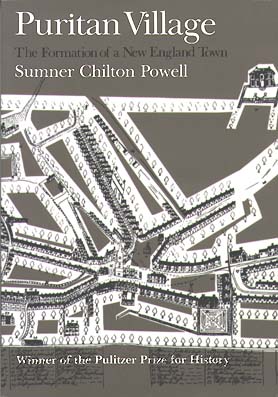 Puritan Village: The Formation of a New England Town
Puritan Village: The Formation of a New England Town Puritan Village: The Formation of a New England Town
Puritan Village: The Formation of a New England Townby Sumner Chilton Powell
Wesleyan Univ. Press, Middletown, Connecticut, 1963
215 pp., 5 1/2 x 8 in.
paperback ISBN 0819560146
A review for Axtell researchers by Daniel G. Axtell
Sumner Chilton Powell won the Pulitzer Prize in History in 1964 for this detailed study of early government and social organization in Sudbury, Massachusetts. He chose Sudbury because of the relatively-complete town records from settlement in 1638 to 1660. Historians had long debated how the government and social structure of typical New England towns developed. Powell finds that no New England town can be labeled "typical". He traces all of the early settlers (all English Puritans) back to England and finds that there were no typical "English" towns and no typical "Puritans." The ideals and compromises of early Sudbury were an unpredictable result of many individual experiences brought together in a wilderness. They obviously weren't thinking about creating a better society for future generations; they were mostly just trying to survive using the skills they brought from England.
Puritan Village is written for history scholars and assumes that readers are familiar that period of history. Others should plan on reading it twice in order to understand many of the references. It's only 146 pages without the notes and appendixes. I've put together a glossary of 17th Century English terms that you can print out and use to help you through the book.
Why this book is of interest to Axtells
Powell set out to trace the families of all the original settlers of Sudbury back to England. He describes the daily lives back in England of the families and communities of the emigrants. In doing so, he documents some great information about Thomas's childhood home, Berkhamsted. He uncovers much about Thomas's father, William, including land holdings and offices held. William variously served as stonewarden (overseeing road repair), churchwarden (a layman overseeing parish property), sideman (reporting church offenses), chief burgess (overseeing borough affairs), mayor (the chief executive of the borough--the mayor and 12 chief burgesses comprised the common council), and town clerk.
Thomas emigrated in 1642 at age 23. He must have observed his father's work and been familiar with town government, but he was not active in the government of Sudbury, Massachusetts. Powell speculates that he was simply younger than the other settlers. Also, he arrived 4 years after the original settlers. He died just 4 years after that and never played a large role in the new settlement.
Henry, Thomas's only son, was among the unhappy second generation who did not get free grants of land in Sudbury. The system for distribution of land developed by the original settlers had been short-sighted. The conflict began in 1655 and Marlborough, to the west, was incorporated in 1660. Henry was one of the first grantees. The new town discarded all remnants of the cooperative, open-field farm system. Land was granted as house lots and farm land all in one piece.
As can be expected, there is no mention of the wives, Thomasine, Mary, and Hannah. This is not an omission by Powell. He used historical documents and women rarely were mentioned.
Powell gives a sense of the daily life and the values in the English towns and in the wilderness settlement of Sudbury. With so little information about the first 2 generations of Axtells in America, this book is the best source for imagining how they lived. We may never know Thomas's reasons for leaving his home for America, but Puritan Village describes several good reasons for emigration. In any case, it was obviously not an easy decision for a 23-year-old with 2 very young children. Possible reasons for leaving England included:
These reasons make it easier to imagine taking your family to a distant colony of the British Empire to get away from high taxes, persecution, and possible violence. But many Puritans, including Thomas's brother Daniel, stayed behind. We may never know what finally prompted Thomas to uproot his family.
A sampling of other interesting details you will find:
In short, anyone interested in early Axtell genealogy will learn much from this book. Also, this book is for anyone visiting Sudbury for a genealogical pilgrimage. The book is clearly intended for history scholars. It would reach a broader audience if it had a glossary. I have compiled one here to help genealogical researchers.
Puritan Village is in print and available through bookstores. To find the best price, try bookfinder.com to search on-line bookstores (new and used). There are many unfamiliar historical terms used in the book. A very helpful reference while you're reading Puritan Village is The Oxford Companion to Local and Family History (edited by David Hey, Oxford University Press 1996. ISBN 0-19-860215-4 paperback). You can probably get both books from your local library by asking for interlibrary loan, if necessary.
Copyrighted material from Puritan Village used on this webpage is intended to
be allowable use for a review.
Back to Axtell Genealogy
[AFO Home] [The Name] [Genealogy] [Places] [Notables] [Businesses] [Album]